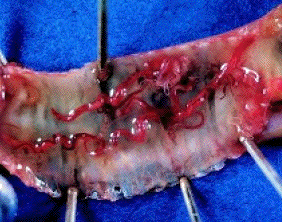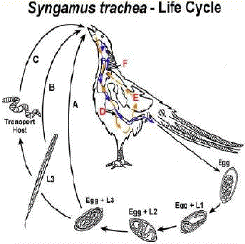- En médecine
vétérinaire, une maladie touchant
des gallinacés est appelée
bâille-bec, ou maladie des
bâillements synonyme de
Syngamose aviaire (Némathelminthe du
tractus respiratoire)
-
- On trouve dans la
trachée des faisandeaux, par exemple, un
ver dont le mâle et la femelle sont
accouplés en permanence donnant au
parasite un aspect en Y, d'où le nom de
ver fourchu. Ces vers fourchus se forment en
paquet dans la trachée. Ils gênent
la respiration et fatiguent les jeunes faisans.
La tradition expliqe ces bâillements pour
leur supposé effet de faciliter la
respiration d'où le nom de maladie du
bâillement ou bâille-bec. L'angoisse
et des troubles métaboliques secondaires
à la détresse respiratoire peuvent
expliquer ce symptôme.
-
- Cette affection
parasitaire entraîne une forte
mortalité avec lésions
pulmonaires. (E. Garcin, Guide
vétér., 1944, p. 107)
-
  - Syngamus
trachea
-
- Les vers adultes
s'accouplent (une grosse femmelle, un petit
mâle) et restent attachés par les
organes reproducteurs toute leur vie d'oû
le nom syngamie. Les oeufs pondus dans la
trachée sont déglutis et
éliminés dans les fientes.
après une incubation requérant
25°C, deux mues successives aboutissent
à la larve infestante en dix à
quinze jours. Après ingestion, la larve
migre vers les alvéoles pulmonaires, se
transforme peu à peu en vers adulte qui
gagne la trachée pour s'accoupler ...
pour toute sa vie estimée à 150
à 250 jours. C'est un parasite
hématophage à tous les stades de
type némathelminte.
-
- Les volailles
infestée manifestent une dyspnée
intense, de la toux, des
bâillements intermittents ou
continus. Le diagnostic est assuré par la
découverte des "vers fourchus" dans la
trachée.
-
Gapeworms
:
a
syngamy for life
-
- The male and female
gapeworms remain inseparably joined by
their genitalia for as long as they live. Their
lifelong coitus is so complete that they cannot
be separated without getting their limbs torn
off. The two partners form a Y or fork with two
teeth. The eggs that they produce are coughed up
into the bird's throat together with pieces of
tracheal mucosa. Most of the eggs are swallowed
and expelled with the faeces, but a small
quantity are vomited directly by the beak or
sneezed out through the nostrils. Sometimes
whole worms are disgorged by the
beak.
-
 -
- The life cycle of the
gapeworm starts with minuscule eggs,
which are spread around the vicinity of infected
birds. When the eggs end up in a favourable
environment, they develop into larvae within 2-3
weeks. Those eggs with larvae, or free larvae,
are frequently eaten by earthworms, snails and
dung beetles. These play the role of transport
hosts and serve as storage depots. In
earthworms, for example, the infectious larvae
of the gapeworm remain well preserved for more
than 4 years.
-
- When a pheasant pecks up
the infected intermediate host, the gapeworm
larvae start to migrate through the alimentary
canal, the blood vessels, the heart and the
lungs. In this way, they finish up in the bird's
windpipe, where they soon develop into
full-grown, egg-laying gapeworms.
-
- A lump in the
throat
-
- The first symptoms become
visible between the 6th and the 8th day after
infection, when the larvae migrate through the
lungs. This provokes a localised pneumonia. The
greatest damage, however, is caused by adult
worms in the windpipe from the 18th to the 20th
day after infection, which bring about
irritation, anaemia and asphyxia.
-
- The pheasant tosses its
head backwards and forwards in a vain attempt to
rid itself of the troublesome parasite in its
throat. One characteristic of the infection is
the wheezing cough; another is the way in which
the pheasant gasps for air with
wide-opened beak, fighting to inhale. Ultimately
it chokes to death as a result of an
accumulation of the worms and mucus, which
clump, thereby closing off the
windpipe.
-
- Young pheasants in
particular, whose windpipe has a small diameter,
soon find themselves desperately short of
breath. Sometimes they die only 3 days after
infection. A mortality of 10% is not uncommon.
By the age of 2-3 months, infected pheasants get
rid of their gapeworms spontaneously, and
with age develop resistance.
|



